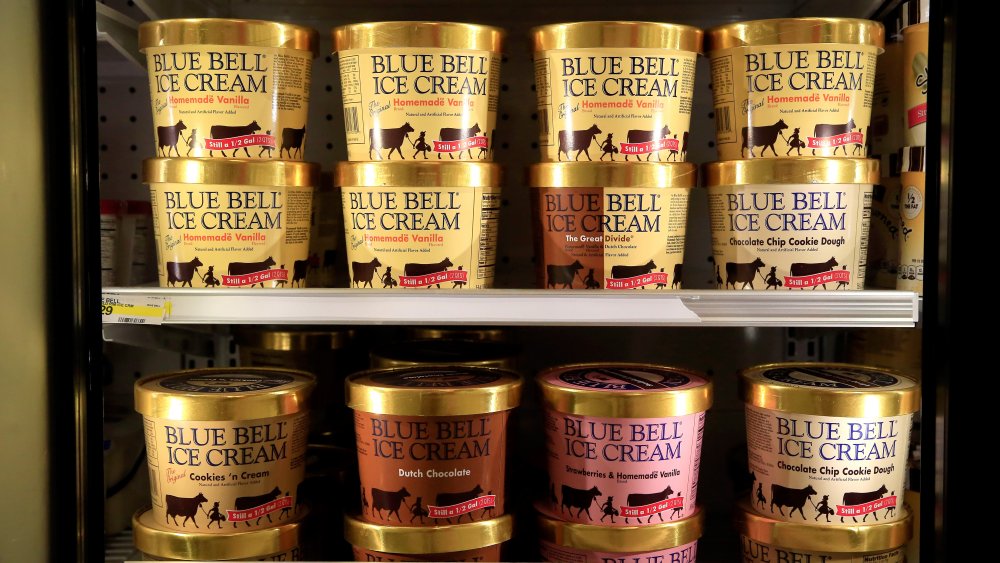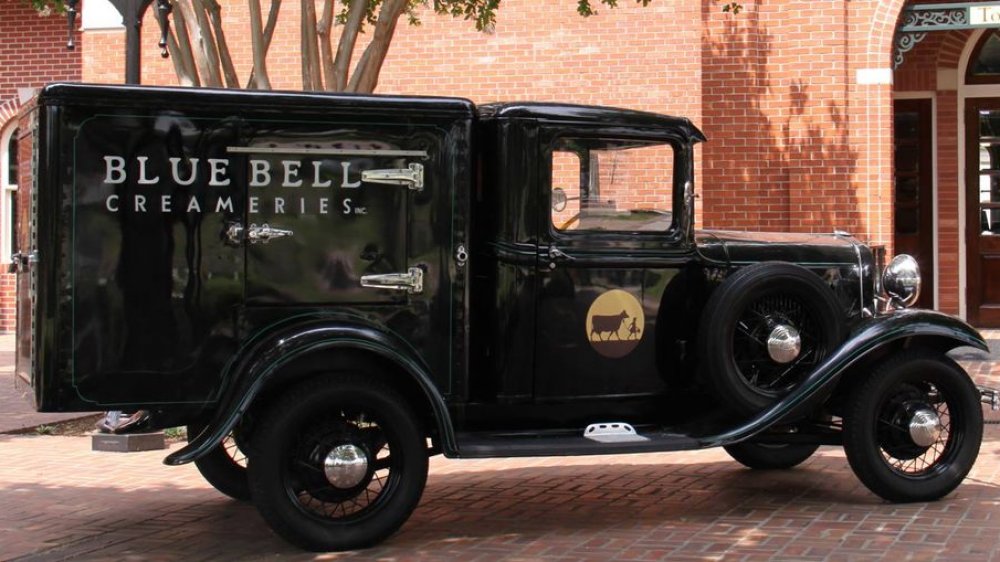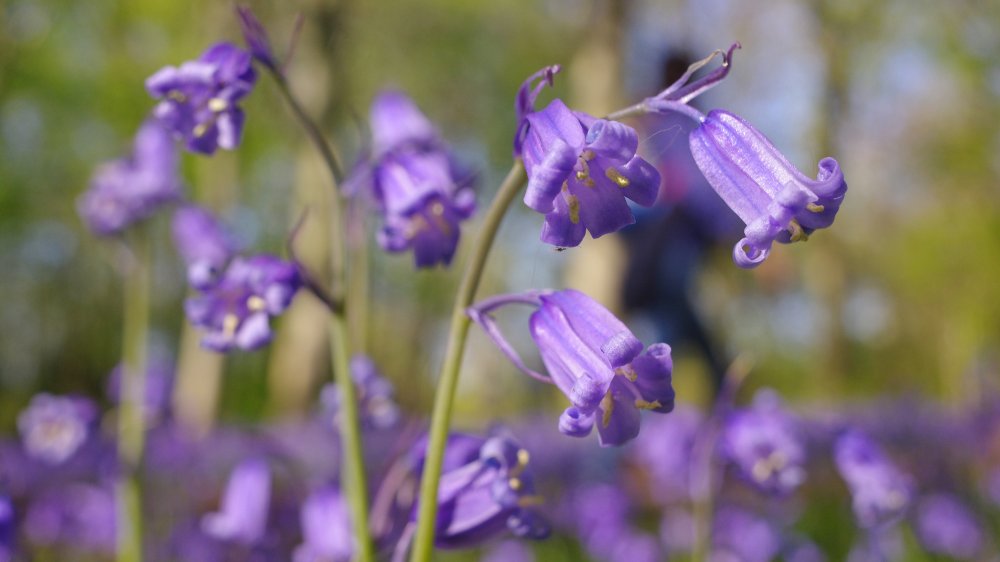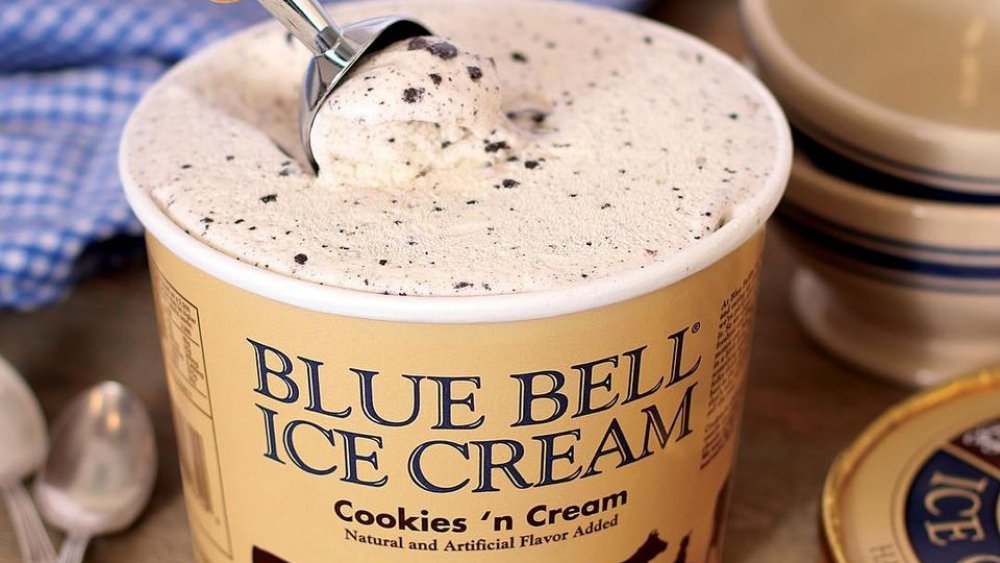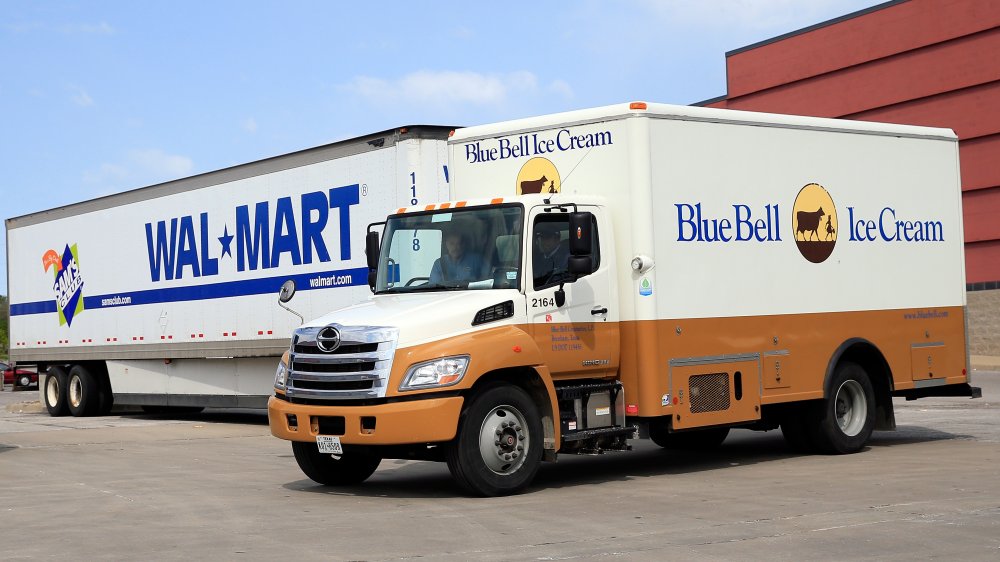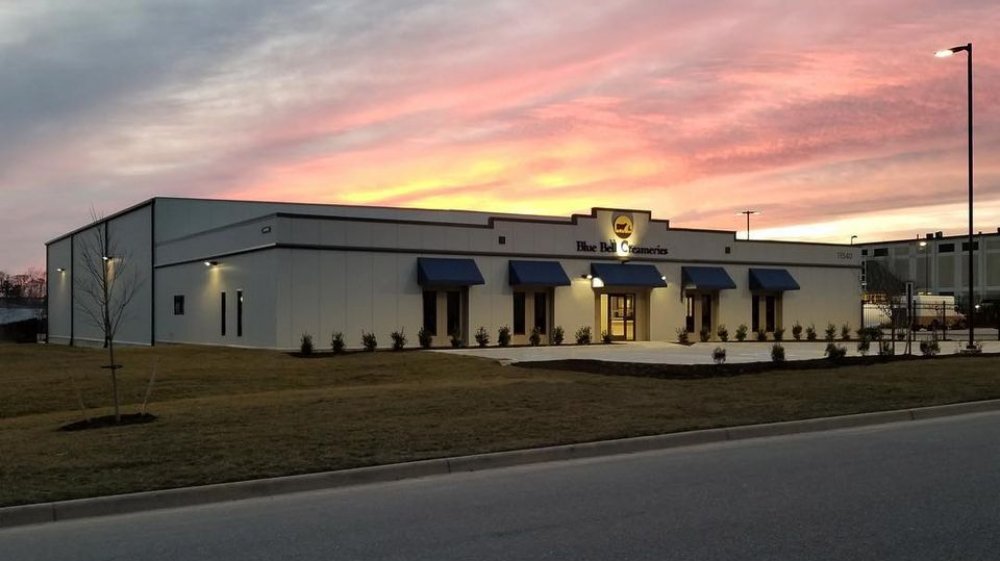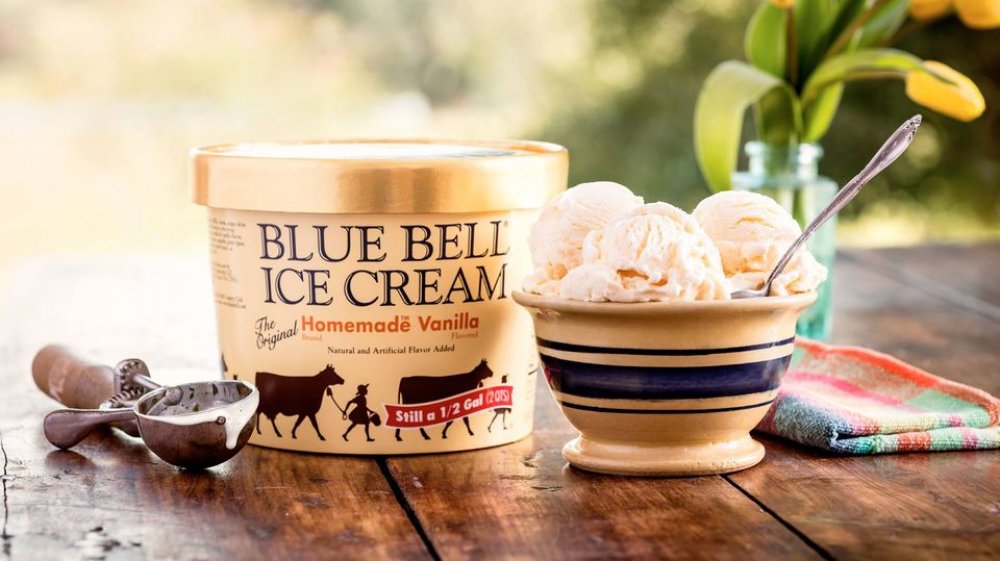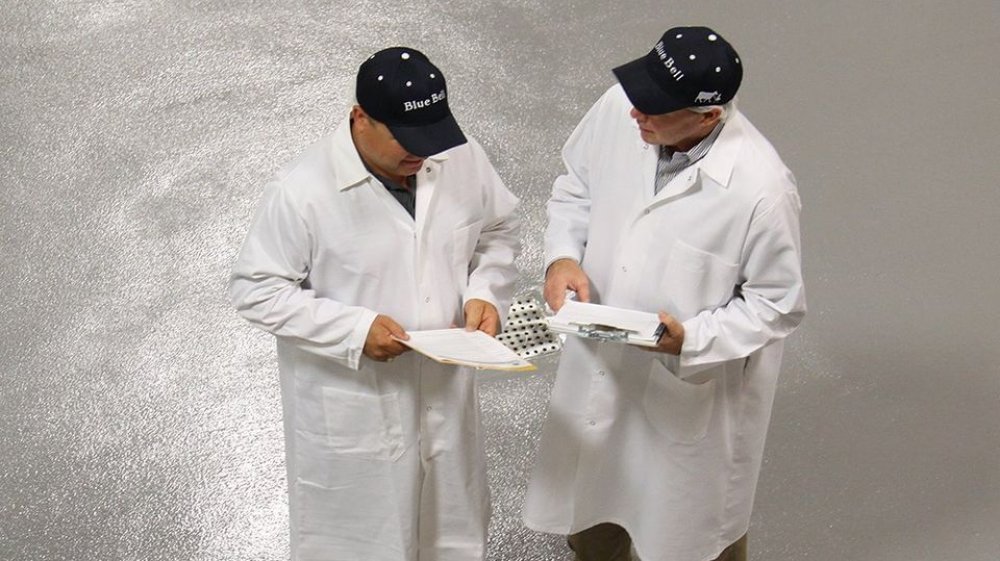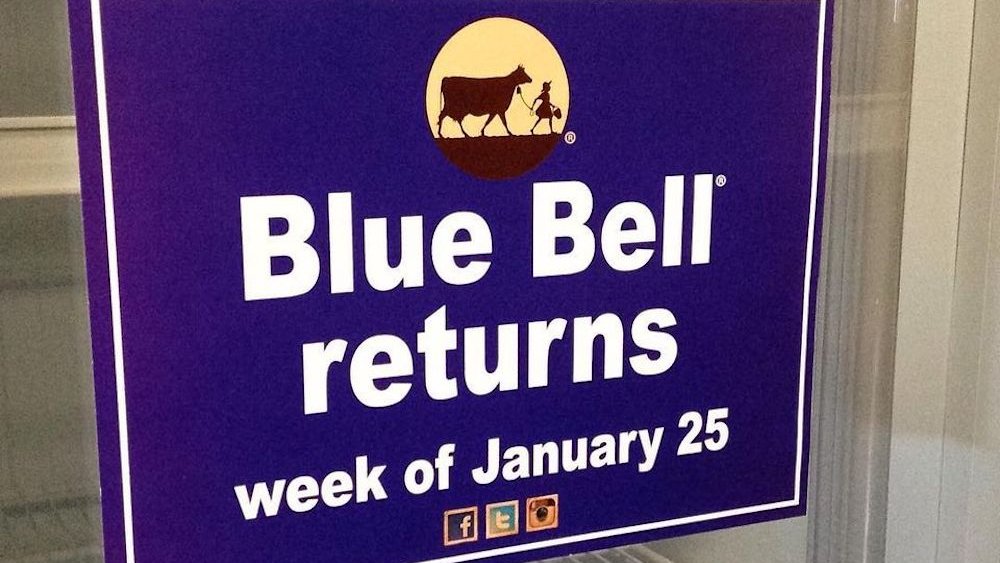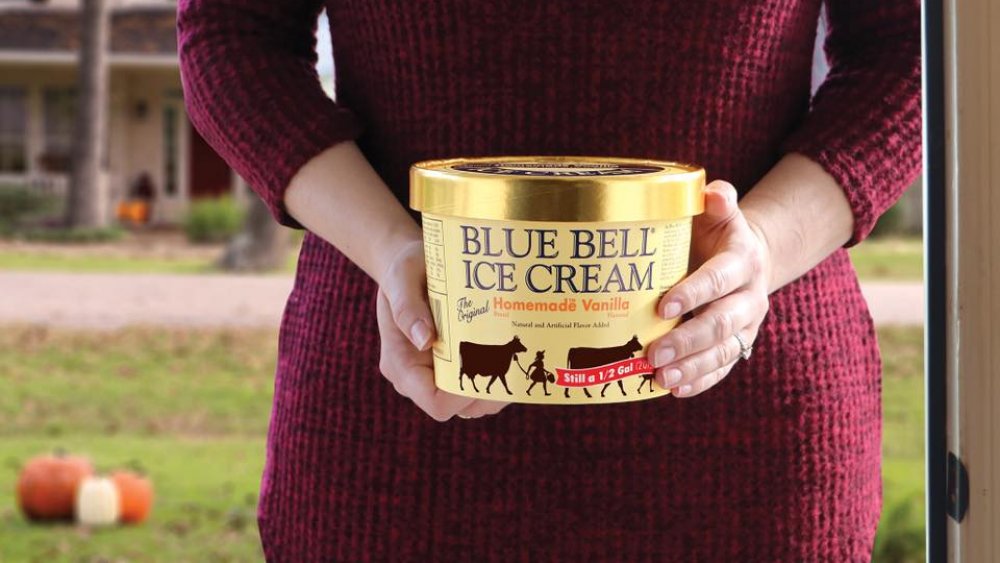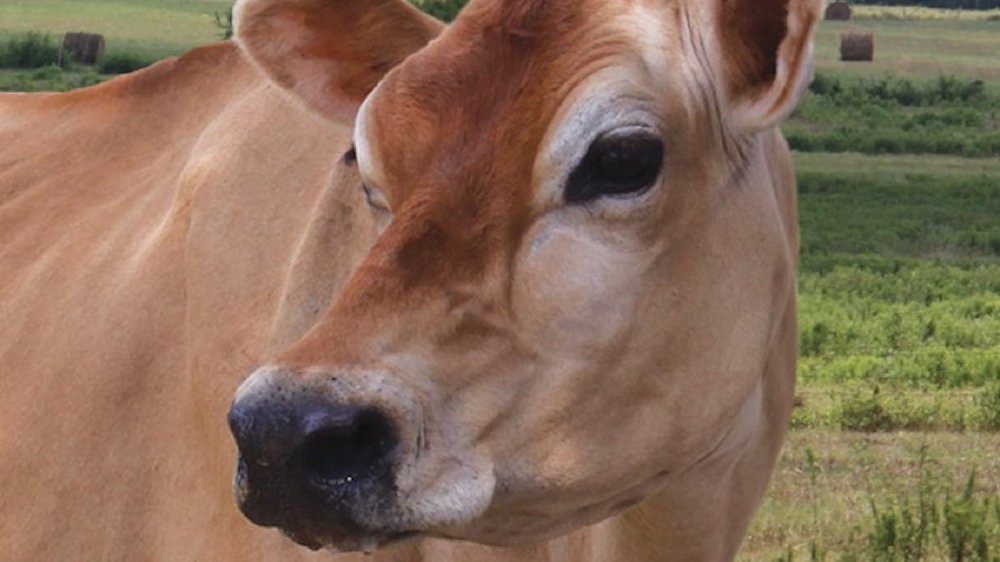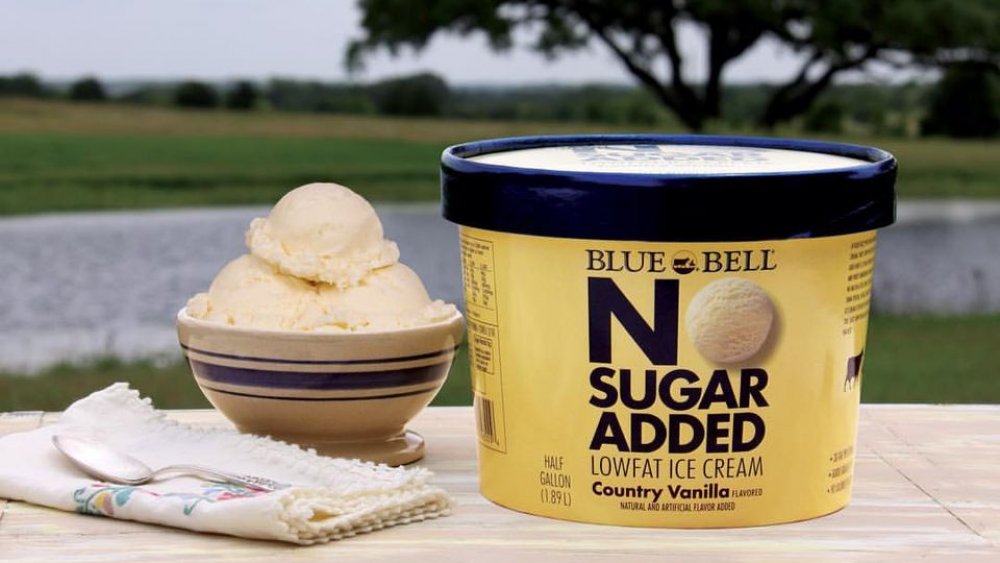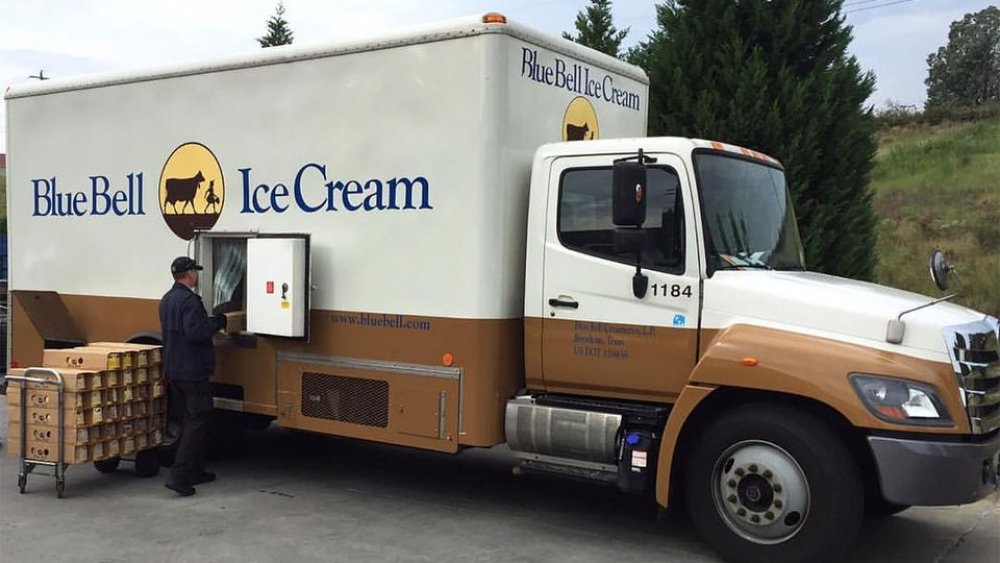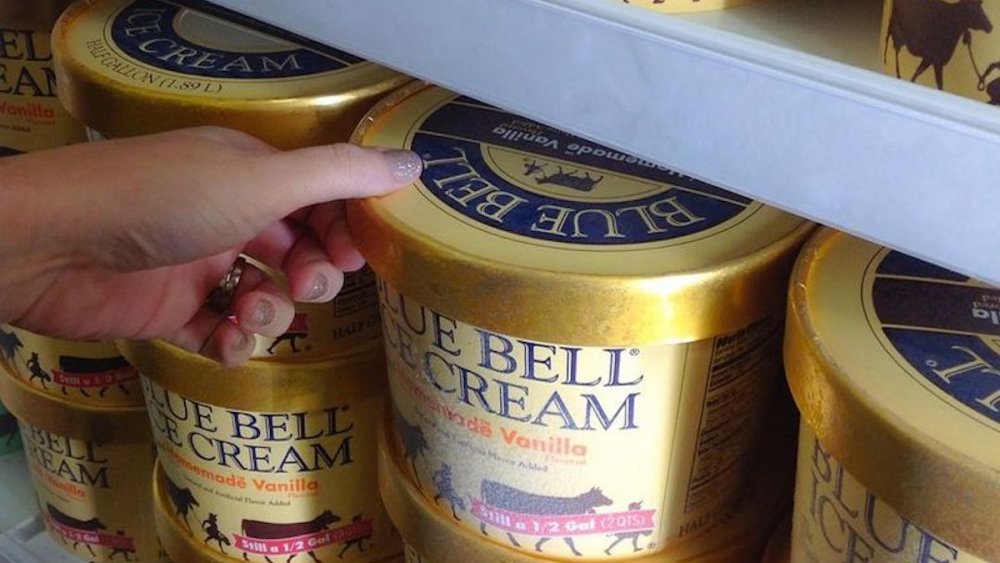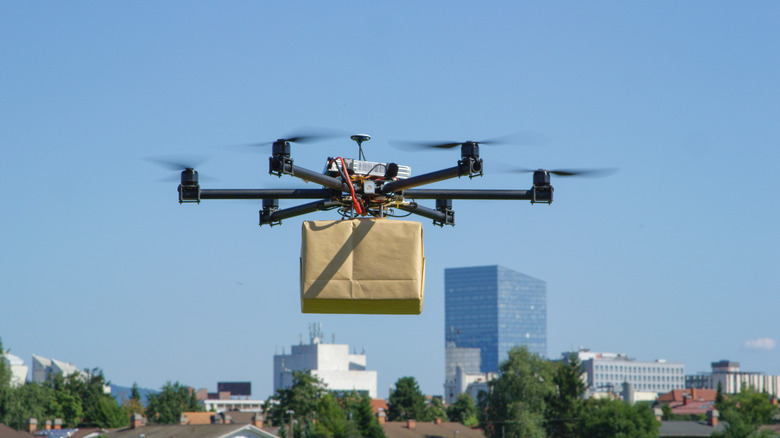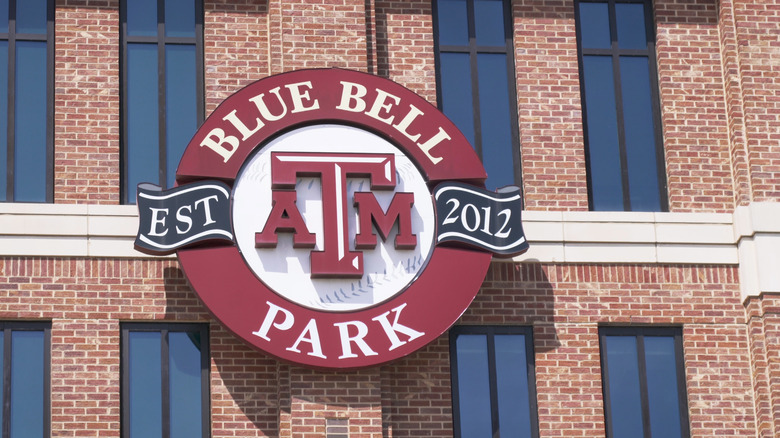The Untold Truth Of Blue Bell Ice Cream
In Texas and other parts of the Southeastern United States, it's not summer without Blue Bell ice cream. The regional favorite is the go-to choice on a hot and humid day (or a cold one, this is a no-judgment zone). It's an ice cream brand with a small town feel and image, but a big business reputation and a devoted following of ice cream lovers who load up their freezers with the stuff — even following a listeria outbreak (more on that later).
Yet, even the most dedicated Blue Bell fans probably don't know the full history of this popular ice cream brand. From its claims that it invented one of the most popular ice cream flavors in the country, to how its limited distribution helped return a missing person to her home, the brand has a history nearly as rich as its flavors. This is everything you need to know about Blue Bell before grabbing another half-gallon tub from the freezer aisle.
Blue Bell started in 1907 as a way to use excess cream from local dairy farmers
The company that is now known as Blue Bell started in 1907 as the Brenham Creamery Company. The name made sense at the time for the men who started it, since it was located in the small town of Brenham, Texas. Dairy farmers in the region would bring their excess cream to the Brenham Creamery Company where it would be turned into butter. That was the first and only product for a few years until ice cream made it to the production lines in 1911. Ice cream was a small operation at first — the Texas State Historical Association notes only two gallons of ice cream were made a day inside ice-filled wooden tubs in those early years.
It would be another four decades before ice cream became the main focus. The company made butter until 1958, according to Blue Bell's history. The pivot was a good choice, as it's hard to imagine Blue Bell's butter becoming as big of a cult favorite as Blue Bell's ice cream has.
Blue Bell ice cream is named after a Texas wildflower
Blue Bell is Texas through and through, so it's only natural that the brand is named after a ubiquitous Texas wildflower. In 1930, the company changed its name to Blue Bell Creameries after 19 years of going by Brenham Creamery Company. The switch was due to general manager E.F. Kruse, a teacher who was brought on in 1919 and whose descendants are still involved with the company. Kruse was tasked with righting the company, according to Southern Living, and he figured a new name would help.
Though Kruse chose a popular Texas wildflower, he did not pick the one most associated with the state at the time. The similar bluebonnet flower, which is a member of the legume family, was named the official state flower in 1901, according to Kera News. Bluebells (the plant, not the ice cream) bloom bell-shaped flowers from bulbs in the spring — just around the same time hot weather brings ice cream cravings. They are not to be confused with bluebonnets, which grow wild in the dry parts of Texas and have blue flowers with white tips.
Blue Bell claims it was the first to make cookies and cream ice cream
Cookies and cream ice cream is a favorite found pretty much wherever you can find ice cream these days. Depending on which history you choose to believe, you have Blue Bell to thank for that. The Blue Bell products page for its Cookies 'n Cream flavor makes a bold origin claim: "We were first to create this innovative flavor."
It's a claim under a fair amount of dispute. In a 2006 New York Times story, writer R. W. Apple Jr. wrote that "Blue Bell makes no claim to have invented it but it certainly pioneered the flavor" by originally adding Oreo cookies from Nabisco by hand. South Dakota State University claims that dairy plant manager Shirley Seas and students Joe Leedom and Joe Van Treek were the first to invent what they called Oreo ice cream in 1979. Steve Herrell's of Herrell's Ice Cream claims he first invented the flavor after starting his company in 1973. And then there's John Harrison from Edy's, who told the Chicago Sun-Times in 2003 that he was the first to put Oreo cookies in ice cream.
Blue Bell tried to cement its name in Cookies 'n Cream history by filing for a trademark for the flavor in 1981. The application claims Blue Bell's first use was in December of 1978, but by 1984, the "trademark application was refused, dismissed, or invalidated by the Office."
Blue Bell ice cream is only available in 23 states
Today, ice cream lovers can find Blue Bell on the shelves in 23 states. Most of the locations are in the South, along with parts of Colorado and Indiana (a handy "where to buy" tool on the Blue Bell website is there to assist anyone on the hunt for a half-gallon). While some might consider that a relatively small distribution footprint for such a well-known brand, it used to be even smaller. Blue Bell ice cream didn't even make it to Houston, around 70 miles away, until 1960, according to a story in the Houston Chronicle. The company was also rather slow to make it out of the Lone Star State, and didn't cross the Texas border until the 1980s.
A commitment to a direct store delivery program (meaning only Blue Bell employees handle the product until it makes it to the grocery store, rather than outsourcing deliveries to a third-party company) is one thing that keeps the distribution limited. Today, there are factories in Sylacauga, Alabama, and Broken Arrow, Oklahoma, to help with getting the ice cream to farther reaches than Texas.
When asked by The New York Times why the company doesn't just go and take over the rest of the country's freezers, top company brass gave a folksy answer of, "It's a cinch by the inch but it's hard by the yard," and added that "The milk we use is so fresh it was grass only yesterday."
Blue Bell tried to make a dill pickle flavor, but it never took off
For every hit new flavor like Cookies 'n Cream, there's bound to be a few spoiled tries. For Blue Bell, that includes an attempt at Dill Pickle 'n Cream, according to Houston History Magazine. The idea was to make the ice cream green and put bits of pickle chips in it. In theory, these two things could work. Ice cream is good, and pickles are good. Together, though, they were a non-starter.
The failed Dill Pickle 'n Cream is joined by other flavors that simply couldn't take off. There was a raspberry ice cream that turned the eater's mouth purple called Purple Fink Bar. Even less bizarre ice cream flavors like a peanut butter ice cream and one flavored with macadamia couldn't cut it, Houston History Magazine notes. Some new flavor ideas come from employees, while others come from fans of the brand. Failure is just one part of innovation, though, and Blue Bell has a long list of successful regional and seasonal flavors, like the Florida-inspired key lime pie ice cream.
Homemade Vanilla is Blue Bell's most popular flavor
In 1969, Blue Bell's president Howard Kruse (related to the Kruse who came up with the company name) created what would become the brand's most popular offering: homemade vanilla. Kruse told the Houston Chronicle that Blue Bell was the first to use "homemade" when releasing a vanilla flavor, though that's just as hard to prove as the Cookies 'n Cream claim. Regardless, homemade vanilla was a splash.
Blue Bell's website says homemade vanilla is the company's "most popular ice cream and with good reason," citing a "special hand-cranked flavor." It's not, however, literally hand-cranked ice cream, as it would take a whole lot of hands doing a whole lot of cranking to make as much homemade vanilla as the company sells. In 2014, according to AL.com, homemade vanilla made up around 60% of sales, followed by Dutch chocolate and cookies 'n cream.
It's not the only vanilla flavor Blue Bell offers, either. There's also natural vanilla bean, which has black flecks of vanilla bean in the finished product.
Blue Bell tried to cover up a listeria scandal
Blue Bell was quickly growing throughout the 2010s when it was faced with the biggest scandal in company history in 2015. In February of that year, a listeria outbreak was traced back to the Brenham, Texas factory by state health officials. Listeria monocytogenes can be deadly for pregnant women, newborns, the elderly, and anyone with a compromised immune system, and it was on the company to correct the issue in the name of public health.
According to a government report, health officials found more listeria in a different product two weeks after the first testing, and then more listeria at the factory in Broken Arrow, Oklahoma. Improper cleaning and a hot water issue caused the listeria growth. Five people in Kansas went to the hospital with listeria traced back to Blue Bell ice cream.
The public lost trust in the product and Blue Bell had to shut down its factories, but the problems didn't end there. Blue Bell didn't make a formal statement to customers, and the company and Paul Kruse, who was president at the time, were charged in federal court with covering up the incident by the Justice Department. Blue Bell pled guilty and paid $17.25 million in fines and $2.1 million to settle a civil False Claims Act case. Kruse was also charged with seven felony counts of covering up the listeria outbreak by telling employees to clear out potentially contaminated ice cream without telling retailers or consumers.
Dedicated fans started selling black market Blue Bell after the listeria scandal
Even listeria wasn't enough to stop Blue Bell fanaticism for some people. After word got out, a Craigslist ad went up for some homemade vanilla.
"I have half a tub of Blue {Bell} Homemade Vanilla flavor ice cream left," the ad said, captured in a screenshot by reporter Jeff Paul. "No listeria (I ate the first half and i'm still here). I am willing to sample the blue bell in front of legitimate buyers (Legitimate meaning CASH in HAND). Please reply to posting Can't guarantee it for long......I might get hungry! Pics coming soon."
The condition of the half tub was listed as "excellent," and the asking price was $500. Food Safety News found other reports of people selling black market "pre-listeria" Blue Bell across Texas. Blue Bell, for its part, addressed the news with a statement that read "Please don't consume Blue Bell products. Instead, please return the product to the store where you purchased it for a refund."
Blue Bell is the fourth largest ice cream company in the United States
For a brand associated with down-home ice cream and product names like homemade vanilla, Blue Bell sure does have a big influence in the total ice cream market. Blue Bell has regularly been among the top five selling ice cream brands in the United States, despite distributing to less than half the country. It was the third-largest ice cream manufacturer with 6.4 percent of the ice cream market in 2014 after Nestlé and Unilever, according to the New York Times. The listeria outbreak caused a major shakeup, though. It fell out of the top 15 ice cream brands following the recall, according to Forbes.
Today, Blue Bell has moved back up in the ranks. IBIS World listed it as the fourth largest ice cream company in 2020. The first is Unilever (which makes Magnum bars and Breyers, among others), the second is Nestlé (Dreyer's, Häagen-Dazs, and others), and the third is Wells Enterprises (Blue Bunny, Halo Top). In terms of individual ice cream brands rather than overall companies, Statista notes that Blue Bell is third after Ben & Jerry's at number one and Häagen-Dazs at number two.
There's an official Blue Bell cow mascot named Belle
There would be no ice cream without milk. So a Blue Bell advertising employee decided that there was no better spokescharacter than a cow. Specifically, an anthropomorphized Jersey cow from LaGrange, Texas named Belle.
Belle has made many appearances over the past couple of decades. In a 1991 commercial, Belle sang opera while a little girl, rabbits, and piglets ran to find where the singing was coming from and a voiceover told viewers that "her milk was divine," and that "there's a little Belle in every pint of Blue Bell ice cream."
Belle made it online in 2018 with a blog, and the first post announced that she'd "been around Blue Bell for a very long time." It also mentioned all the Blue Bell commercials featuring cows, and the fact that Belle is a cow that sings and wears pearls in addition to being featured on all of the ice cream cartons. The blog didn't last, but like pretty much everything else on the internet, the words of Belle (or rather, the words of the marketing employee forced to write in the voice of a Jersey cow) live on.
Blue Bell started a line of diet ice creams in the 1960s
Ice cream should not be anywhere near the top of the list when it comes to people searching for health foods, but that doesn't mean there aren't ice creams that are slightly less unhealthy than others. Blue Bell got onto the health fad early when it released a set of diet ice creams in the 1960s, according to Houston History Magazine. The first was the low-calorie Slenderette. That was followed by a number of flavors that used Nutrasweet in 1989. Nutrasweet is a brand that makes the artificial sweetener aspartame, and the Blue Bell ice creams that used it were the first diet ice creams to come in half-gallon containers (Blue Bell is known for its dedication to the half-gallon rather than the pint, and not even diet ice cream could get in the way of that).
Blue Bell continues to target health-conscious consumers today with homemade vanilla light, which is like the brand's most popular flavor, just with less fat and calories. There's also no sugar added country vanilla, which is an "old fashioned, down-home vanilla that reflects the rich, creamy flavor of the country."
Blue Bell's limited distribution helped police return a missing person in 1991
There is one upside to Blue Bell's limited distribution: It's a lot easier to pinpoint where it came from. Houston History Magazine detailed one case in 1991 where that limited distribution played a part in returning a woman lost in the Grand Canyon to her home. When found, the woman couldn't remember who she was, where she was from, or how she got to the Grand Canyon. She was able to recall three things to a sheriff, however. One was the Delchamps grocery chain, the second was that there is a river, and the third was a Blue Bell slogan.
The sheriff worked together with Blue Bell to give meaning to those three statements. Turns out Blue Bell distributed ice cream in the Delchamps grocery stores in the part of Texas that's divided from Louisiana by the Sabine River. When local news stations reported the story, the lost woman's parents were able to identify her.
There was a Blue Bell licking scandal
Blue Bell was the target of a viral online prank in 2019 called the #IceCreamChallenge, where people filmed themselves licking ice cream and putting it back on grocery store shelves. The first instance happened to a half-gallon of tin roof at a Walmart in Lufkin, Texas, according to CNN. The woman posted the video on Twitter and it racked up more than 11 million views before local police caught her. Her name was never released because she was a juvenile at the time, but that didn't stop her from inspiring more people to do what Blue Bell called a "malicious act" that forced them to remove all of the containers of Tin Roof ice cream from the Lufkin Walmart.
In 2020, the lickers returned. And as is bound to happen when posting something like the #IceCreamChallenge on social media, the person was once again caught. The latest time, however, the person was caught and ordered to pay more than $2,500 in fines and serve 30 days in jail, according to a March 2020 CNN story. More than $1,500 of that money went to Blue Bell Creameries to pay for the ice cream it had to recall in Port Arthur, Texas after the video was posted.
Sales of Blue Bell haven't appeared to have been impacted. Still, you should never lick ice cream and put it back on freezer shelves — because, gross!
Blue Bell teamed up with Chip and Joanna Gaines to create a new line of flavors
Few things are more beloved by Texans than Blue Bell Ice Cream. And yet, one of those things might just be the powerhouse couple of Chip and Joanna Gaines. The Texas residents are best known for their home renovation show, "Fixer Upper," but have also made their name in interior design, publishing, and food and drink, to name a few industries (via Magnolia).
The power couple also own a marketplace in Waco, Texas known as the Silos, which is home to a cafe and a bevy of food trucks. What better place to serve the Lone Star State's favorite ice cream? Blue Bell apparently felt the same way. In March of 2022, the ice cream maker announced it would begin selling a line of five new flavors at the marketplace (via Southern Living). According to Magnolia, the flavors were inspired by recipes from Joanna's cookbook and the couple's hometown of Waco. One particularly special ingredient included in two of the flavors is a graham cracker sauce, which has never been made by Blue Bell in its 100-plus years of operation.
So, what are these delectable flavors? There's lemony Jo's Lemon Pie, campfire-perfect S'mores at the Silos, sweet and creamy Wacotown Vanilla, rich chocolate Magnolia Press Chocolate Cake, and caramel-packed Chip's Salted Caramel Truffle. Unfortunately, these flavors are only sold at the Silos, but that just gives you another reason to visit Texas.
Blue Bell Ice Cream has been to outer space
Blue Bell might only be sold in 23 states, but its reach extends much further — all the way to outer space, in fact. In 2017, a cargo vehicle was sent to the International Space Station carrying 6,400 pounds of lab equipment, according to NPR. The ship was outfitted with freezers for astronauts to send scientific samples back to Earth. Since the freezers would be empty on the first leg of the trip, NASA decided to send the astronauts a special treat: 30 individual cups of Blue Bell Ice cream. "It is normal for commercial resupply missions to deliver a small amount of fresh food to the astronauts, generally fruits or vegetables, with ice cream only occasionally making the trip," NASA spokesman Daniel Huot said (via The Dallas Morning News).
It turns out, this was not Blue Bell's first out-of-this-world adventure. "Our products have made several trips to space," Blue Bell spokeswoman Jenny Van Dorf told the Morning News. "It seems to be an astronaut favorite. We first sent Blue Bell to space in 1995, and it has been on several missions since [then], including the 2006 Space Shuttle Atlantis and in 2012 on SpaceX."
The only logistical problem with the plan was that the freezers would need to be filled with science samples within a few weeks, meaning the astronauts had to eat all the ice cream within that time. Somehow, we think they managed just fine.
Blue Bell is delivering ice cream to customers' homes via drone
We're not sure about you, but we here at Mashed often dream of ice cream raining down from the sky. Alas, it's always just been sweet-toothed fantasy — until now. In April 2022, the delivery service Wing, which is a subsidiary of Google's parent company Alphabet Inc., announced it will begin delivering Blue Bell Ice Cream to the homes of customers located in Frisco and Little Elm, Texas. But Wing isn't your average delivery company with fleets of trucks crisscrossing the country. Instead, Wing utilizes drones to carry packages through the air, right to customers' doorsteps. When the dessert-carrying drone reaches its destination, according to My San Antonio, it hovers approximately 20 feet away from the residence and lowers the package down to the ground with a tether.
If you thought this couldn't get any better, you're dreaming. According to Community Impact, every time Wing makes a Blue Bell delivery, Frisco Fastpacs receives a donation. Fastpacs is a local nonprofit that works to fight child hunger.
As part of this rollout program, which marks Wing's first commercial delivery service, Wing is also delivering products from local Walgreens stores, prescription pet medications from easyvet, and first aid kits from Texas Health. According to its website, Wing does plan to expand the service to other Dallas-area neighborhoods but no news yet on when — or if — the rest of the country will be able to expect ice cream "rain" any time soon.
There's a baseball stadium on Texas A&M's campus named after Blue Bell
If you find yourself on the campus of Texas A&M, head to the school's baseball field and you'll see a familiar name on the stadium's sign.
In 2010, Blue Bell executives and A&M alums Ed and Howard Kruse donated $7 million on behalf of Blue Bell Creameries to help fund the renovation and expansion of the school's baseball field (via Texas A&M Today). As a thank you, the university renamed the stadium Blue Bell Park. "When we thought of a perfect partner to complete this fantastic facility, the name of one family came to mind," said Miles Marks, president of the 12th Man Foundation, Texas A&M's athletic fundraising organization. "The support of the Kruse's and Blue Bell for Aggie baseball go together like Peaches and Homemade Vanilla!"
"Texas A&M has certainly influenced the way in which we do business at Blue Bell, so what better way to show appreciation from our family and our company than to support this project," Howard Kruse said. The sparkling new ballpark, which is located just 40 miles away from Blue Bell Creameries headquarters, opened in February 2012. Renovations included a new club lounge, additional concessions, lawn seating, and even a children's playground.
